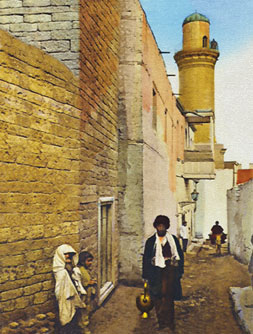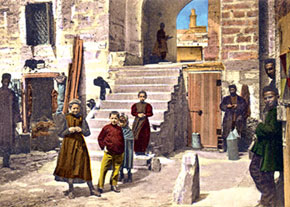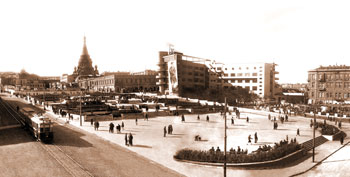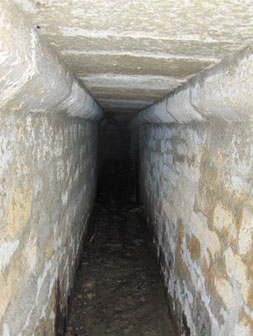| Main » Articles » CAPITAL |
| Entries in category: 12 Shown entries: 1-10 |
Pages: 1 2 » |
Sort by: Name
|
by Kamil Farhadoglu All of Baku used to be located within the area of the presentday Icheri Sheher, i.e. actually Baku was Icheri Sheher. In the first half of the 19th century, the city began to grow and expand beyond the fortress walls. As a result, the fortress came to be called "Icheri Sheher” (Inner City) and what was outside was the "Outer City”. When Icheri Sheher was being built in the Middle Ages, it consisted of twisting streets which defi ned small neighbourhood areas – there were nine in all. Each area centred on its mosque: the Juma mosque, Shah mosque, Mahammadyar mosque, Haji Qayib mosque, Hamamchilar mosque, Siniqqala mosque, Qasim bay mosque etc. Each had its own mullah. Each to his ownSome of the areas were named after people who had arrived in Baku and settled in Icheri Sheher. The Gilaklar block was occupied by merchants who had arrived from Gilan. Gunsmiths from Dagestan lived in the Lezgi block. Most of the population of Icheri Sheher were craftsmen, merchants or sailors. Some areas were named after the professions of the craftsmen who lived there. The Hamamchilar (bathhouse workers), Bazzazlar (leather workers), Hakkakchilar (engravers) etc. The people of Icheri Sheher – Azerbaijanis – also fell into various clans. Some of them had very interesting names. The White-trousers, the Chicken-eaters, the No-Chickens, the Greyheads etc. The Greyheads were so called because their hair went grey early and the White-trousers got their name because they were seamen – and there were various jokes about them. In the past, everyone living in Icheri Sheher had a nickname. Although sometimes these nicknames were quite funny, they did not off end people or cause them to object. At one time there are known to have been four people living there who carried the name Haji Zeynalabdin. Each had a nickname: Plasterer, Mule, Thank-you, No-Cheese. Or Agamali, always ready to give a helping hand, was nicknamed Shortie because he was.... not very tall. |
|
by Kamil Farhadoglu Baku’s incorporation into the Russian Empire in 1806 marked the start of a new phase in the city’s development, both in terms of layout and architecture. The city changed even more dramatically after it was given the status of a governorate in 1859. |
|
by Dr. Kamil Ibrahimov Restoration work in Vahid Park, the former Governor´s Park just outside the walls of Baku´s Old City on the Azneft side, has unearthed an underground passage. Archaeologist Dr Kamil Ibrahimov, senior researcher at the Old City State Historical and Architectural Reserve, looks at the history of the passage and what it tells us about the Old City´s water supply system. First of all, it is important to identify the newly discovered underground passage in historical and archive maps and other sources. |
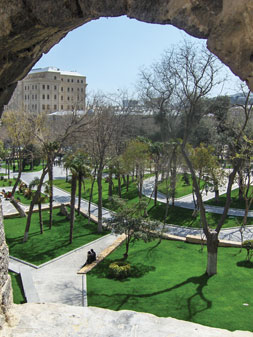 by Kamil Ibrahimov Restoration work is now complete at the Philharmonia Park, just outside the walls of Baku´s Old City. The park, formerly known as the Governor´s Garden or Vahid Park, slopes down towards the Caspian from the Philharmonia Concert Hall. Dr Kamil Ibrahimov, senior researcher at the Old City State Historical and Architectural Reserve, takes a look at how this lush park came to be created in arid Baku. |
|
The Old City of
Icheri Sheher occupies 22 hectares in the center of Baku. It hosts over
50 historical and architectural monuments from various eras. The Palace
of Shirvanshakhs, the Maiden Tower and Synyg Gala (The Broken Tower) are
among the monuments which survived till present day.
|
|
Fire Temple - Ateshgah In early history
Azerbaijan was called the "land of the sacred fire”. Although the
"everlasting fire” mentioned by early travelers such as Alexandre Dumas
was due to the gas and oil deposits erupting from the earth, it became
surrounded by legend and mystery. Some 2,600 years ago, Zarathustra was
formulating Zoroastrianism, one of the first major monotheistic
religions. His idea to use fire as a metaphor for the mysteries of God
probably came from witnessing the spontaneous flames that rise so eerily
from Azerbaijan's Absheron Peninsula. Today some such fires still burn.
Most notable is Yanar Dagh near Mammedli, where a small hillside is
constantly and naturally aflame. On
Absheron there were many temples of Fire as well. From their variety
the most famous is the well-preserved temple Ateshgah ("the Fire Place")
in Surakhany, located 20 kilometers east of the town center. The temple
was built over a pocket of natural gas that fuelled a vent providing an
'eternal' fire. This kind of use of fire in Zoroastrian temples led to
the followers of Zoroaster (Zarathustra).
|
|
Towers of Absheron In the XI-XIII centuries in connection with the consolidation of the Shirvanshahs in the territory of the Apsheron Peninsula a great construction work was carried out. Among the buildings of that time the towers and castles hold a special place; they served as reliable strongholds for the feudal lords in the intestine wars, also as shelters and places of defence during the foreign invasions. Particularly this question was keenly raised in the XII century, when Apsheron was exposed to the attacks of the Russian buccaneers from the sea. Thus in 1175 Shirvanshah Akhistan I repulsed several raids of the Russians, who attacked on 73 vessels.   |
|
Sabael Castle In 1235
Shirvanshah Fariburz III had a fortification built on one of the rocky
islands of the Baku bay which was subsequently called the Sabael Castle,
Shahri Saba, Shahri Nau, the city under water, the caravanserai, the
Bail rocks, etc. Wrapped in legends, the castle is completely under
water at present and is about 350 meters distant from the shore.  Sabael Castle |
|
Shirvanshakh's Palace The Shirvanshahs’ Palace ensemble is
the biggest monument of the Shirvan-Apsheron branch of the Azerbaijani
architecture. In the XV century following the rise of economic and
political importance of Baku, which was one of the strongly fortified
fortresses and the main port in the Caspian, Khalulullah, the Shah of
Shirvan, transferred the Shirvanshahs’ residence from Shamakhy to Baku.
|

